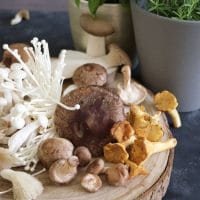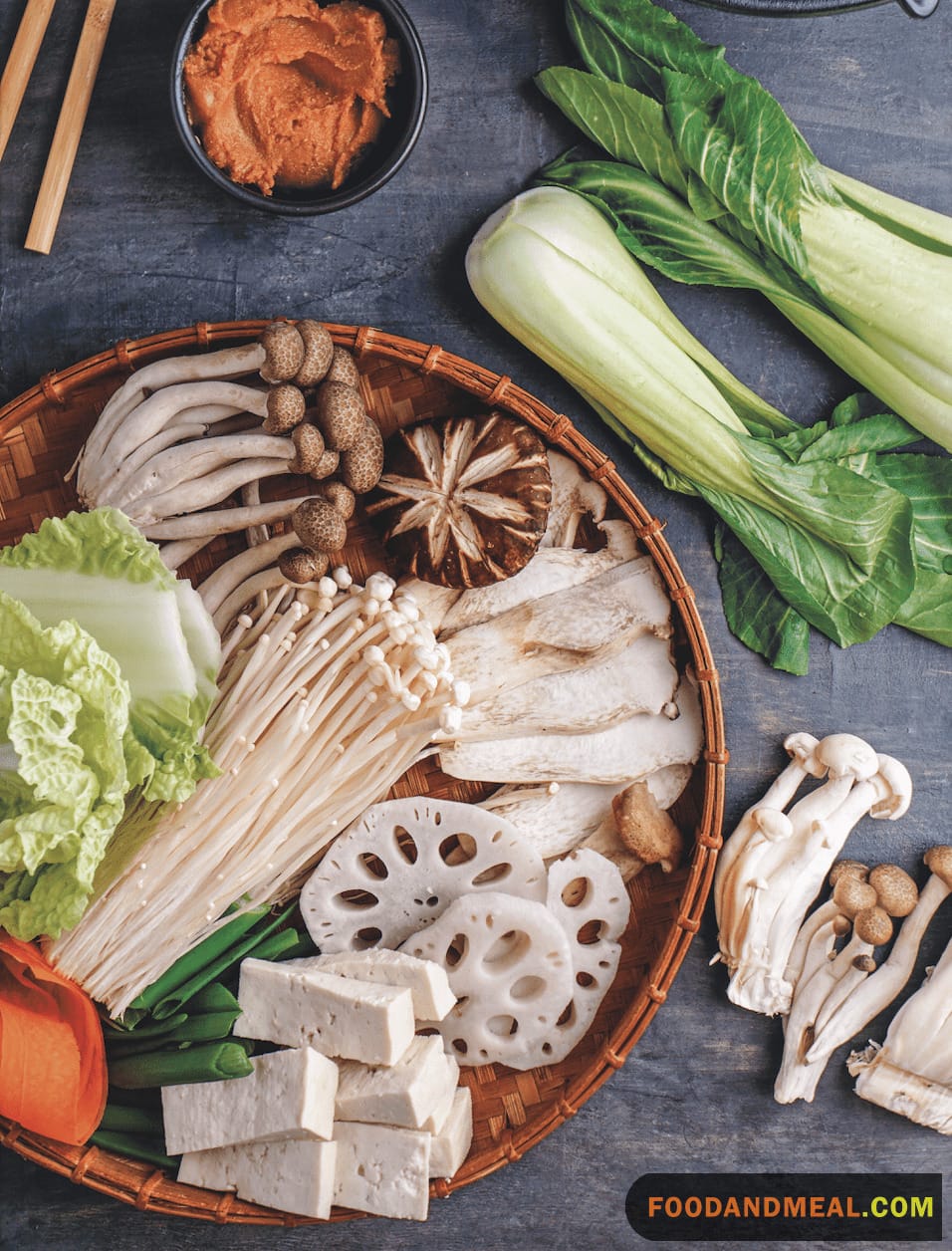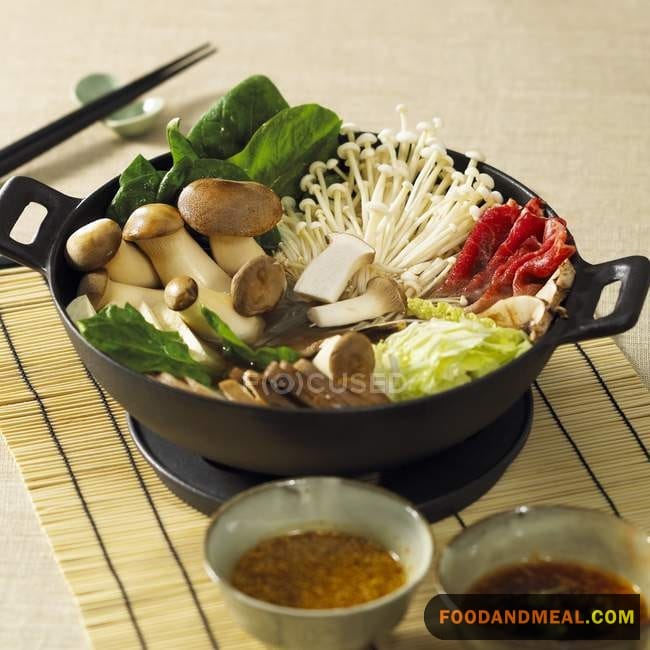Nestled in the comfort of my kitchen at Food And Meal, a place where food transcends mere sustenance and becomes an exploration of cultures, I often reminisce about the first time I encountered this delightful dish. The experience was nothing short of revelatory. There’s something magical about the communal nature of a hot pot, a centuries-old tradition that brings people together, encouraging a shared experience that’s as much about the company as it is about the food itself.
The Japanese Mushroom Oyster Hot Pot, or ‘Kinoko to Kaki no Nabe’ as it’s traditionally known, embodies the subtle elegance of Japanese cooking. It’s a harmonious blend of delicate flavors and textures, featuring succulent oysters and an assortment of mushrooms, each adding its unique voice to the chorus of tastes and aromas.
On a personal note, this dish holds a special place in my heart. It reminds me of the tranquil afternoons spent traversing the misty forests of Japan, foraging for the finest mushrooms the earth had to offer. The earthy notes of shiitake, the robust character of maitake, and the silky finish of enoki mushrooms come together in a broth that’s light yet deeply flavored, providing a base that complements the briny freshness of oysters.
When I decided to make this dish at home, it was not just to satiate a craving for something warm; it was a decision to recreate a moment of tranquility, a chance to pause and reflect amidst the hustle of everyday life. This recipe is my humble attempt to capture the essence of those quiet forests and the serene shores from which these oysters hail, bringing a slice of that serenity into your homes and onto your tables.

Mushroom Oyster Hot Pot Recipe

Japanese Mushroom Oyster Hot Pot
Ingredients
- 3 oz. of noodles, potato starch, dried (kuzukiri)
- 12 oysters, shells removed, with any debris cleaned out
- 4 de-stalked mushrooms, shiitake
- 14 oz. of mushrooms, mixed shimeji and enoki, etc.
- 5 leaves of cabbage, Napa
- 1⁄2 bunch of stem-trimmed chrysanthemum leaves
- 1 diagonally sliced carrot, large
- 1 white part of leek, small, sliced on diagonal into 3⁄4-inch pieces
- 5 & 1/3 oz. of tofu, firm, cut in four pieces
- 54 fl. oz. of broth, dashi
- 1⁄4 cup sake, cooking
- 2 tablespoons mirin
- 2 tablespoons extra soy sauce, Japanese
Instructions
- Soak the noodles in hot filtered water for six to eight minutes, using directions on the packet. Drain them. Arrange the noodles, veggies and oysters in oven-safe, round casserole dish.
- Combine the soy sauce, mirin, sake and dashi and 1⁄2 teaspoons of sea salt in hot pot (nabe dish) on med. heat. Bring up to simmer. Cook for 12-15 minutes, till veggies become tender.
- Provide individual bowls and chopsticks. Allow your guests to cook the tofu cubes in boiling broth. Enjoy with dipping sauce.
Video
Notes
- Adjust to Taste: Remember, the essence of a hot pot lies in its adaptability. Feel free to adjust the ingredients according to your preferences. Found a new mushroom variety? Toss it in! And once you've enjoyed the dish, do share your unique version and subscribe for more tailored recipes from my kitchen!
- The Broth Matters: For an enhanced taste, always ensure your broth is simmered well, allowing the flavors to meld beautifully. The right broth elevates the hot pot experience. Once you've nailed it, don't forget to share your success story and subscribe for more insider tips.
- Freshness is Key: Always choose the freshest oysters for that unbeatable briny kick. The fresher the ingredients, the more vibrant your hot pot will be. Found a trusted oyster supplier? Share the joy in the comments and subscribe for more culinary revelations and secrets!
Nutrition
© Food And Meal
This website provides approximate nutrition information for convenience and as a courtesy only. Nutrition data is gathered primarily from the Spoonacular Database, whenever available, or otherwise other online calculators.
Alternative Method: Mushroom Oyster Hot Pot using a Slow Cooker
To prepare the Mushroom Oyster Hot Pot, begin by combining the chosen base broth (like dashi) with soy sauce, mirin, and sake in a slow cooker. Layer mushrooms at the bottom, followed by fresh oysters, and optionally add tofu or greens.
Cover and simmer on ‘Low’ for 4-5 hours, ensuring flavors meld without overcooking the oysters. Adjust seasoning 30 minutes before serving and add greens if desired.
Turn off the slow cooker and serve the hot pot in bowls, featuring a generous portion of mushrooms, oysters, and flavorful broth. Accompany with ponzu dipping sauce for a heartwarming culinary delight.
Cooking Tips

It’s an act of love and patience, a culinary meditation that invites you to be present in every chop, stir, and simmer. Here are some gentle tips to elevate your hot pot experience, infused with personal insights and a deep respect for the dish’s cultural heritage.
Firstly, the selection of mushrooms is paramount. Each variety brings its own texture and flavor profile to the pot. I suggest taking a moment to appreciate the diversity of mushrooms available to you. Whether you’re using shiitake, maitake, enoki, or others, consider their individual characteristics and how they’ll contribute to the overall harmony of the dish. It’s like composing a symphony where each mushroom plays a distinct yet integral part.
The quality of oysters can’t be overstated. Freshness is key, so I recommend sourcing the best oysters you can find. When you gently place them into the pot, it’s not just about cooking; it’s about honoring the ocean’s gift. The oysters should be plump and have a clean smell, reminiscent of the sea breeze on a crisp morning.
As for the broth, it should be a subtle canvas that allows the ingredients to shine. A dashi base, made from kombu (dried kelp) and katsuobushi (bonito flakes), provides a delicate umami backdrop without overpowering the mushrooms and oysters. It’s important to let the broth simmer quietly, as if whispering secrets to the ingredients it cradles.
In terms of preparation, take care to clean the mushrooms gently, preserving their natural shape and texture. They’re not just food; they’re a testament to nature’s bounty, and they deserve to be treated with tenderness. Similarly, shuck the oysters with care, mindful of their fragile beauty.
When everything comes together in the hot pot, there’s a sense of communal warmth that permeates the air. It’s a reminder that cooking is not just about feeding the body but also about nourishing the spirit. As the ingredients mingle and dance in the steaming broth, take a moment to breathe in the aromatic symphony, letting it wash over you like a wave of comfort.
Finally, when serving the hot pot, do so with a gentle hand and an open heart. Invite your guests to partake in the ritual of sharing, encouraging them to savor each bite with gratitude. This dish is more than a meal; it’s a shared experience that transcends the boundaries of language and culture, uniting us in the universal language of food.
Serving Suggestions for Mushroom Oyster Hot Pot

Pairing the Japanese Mushroom Oyster Hot Pot with these delightful recipes brings a sense of warmth and comfort to the dining experience. The Yakimiso Ramen, with its rich miso flavors, beautifully complements the umami goodness of the hot pot, creating a cozy and satisfying meal that feels like a comforting hug.
Adding Teriyaki Shrimp to the mix introduces a touch of indulgence with its sweet and savory glaze, enhancing the overall taste experience. The Vegetarian Gyoza, filled with flavorful vegetables, adds a delightful contrast in texture and taste, making each bite a small joy.
For those seeking a comforting soup, the Sui-Gyoza Soup with its dumplings is a perfect choice. The warm and savory broth adds an extra layer of coziness to the meal, creating a sense of homely satisfaction.
To round out the Japanese feast, the creamy Tonkotsu Ramen contributes a rich and comforting element that pairs harmoniously with the Mushroom Oyster Hot Pot. Together, these recipes evoke a sense of shared warmth and connection, making the dining experience not just a meal but a delightful journey of flavors and emotions.
FAQs on Mushroom Oyster Hot Pot

- What is in a traditional Japanese hot pot? A traditional Japanese hot pot typically includes a flavorful broth as a base, often made with dashi (a stock made from bonito flakes and kombu seaweed), soy sauce, mirin (a sweet rice wine), and sake. The hot pot is then filled with an assortment of fresh ingredients such as thinly sliced meats (like beef or pork), an array of mushrooms, tofu, vegetables, and seafood, including delicate oysters. The slow simmering of these ingredients allows their flavors to meld, creating a comforting and aromatic dish.
- Can I use dried oysters instead of fresh ones? Certainly! Dried oysters can provide an intense flavor. If using dried, remember to soak them in water for a few hours to rehydrate.
- What can I substitute for sake in the broth? If you don’t have sake, you can use dry sherry or Chinese rice wine. In a pinch, a bit of white wine vinegar combined with water will do.
- How long can I store leftover hot pot in the refrigerator? Leftovers can be refrigerated for up to two days. Ensure the hot pot is cooled down to room temperature before storing.
- Can I freeze the leftovers? While it’s possible to freeze, the texture of the oysters may change upon reheating. It’s best consumed fresh or stored in the refrigerator and consumed within the suggested time frame.
- The broth tastes bland. How can I fix it? You can enhance the flavor by adding a bit more soy sauce, mirin, or a splash of fish sauce for depth. Remember, always add in small increments and taste as you go.
Conclusion
The Japanese Mushroom Oyster Hot Pot is a delicious and nutritious one-pot meal that is easy to make at home. Oyster mushrooms contain a variety of health-promoting compounds and antioxidants that may help fight inflammation, lower cholesterol, and even inhibit cancer cell growth. When combined with other nutrient-rich ingredients like vegetables, tofu, and broth in this comforting recipe, you get a meal that is as good for you as it is comforting and full of flavor.
Be sure to pair this Oyster Mushroom Hot Pot with a side of brown rice or quinoa to make it a well-rounded, nutritious dinner. You can find more recipes and meal ideas on Food and Meal’s recipe blog or get creative and try adding different vegetables, proteins, herbs and spices to this adaptable one-pot recipe.
Hi! I'm Nazia of ‘Nazia Cooks’, a self-taught baker and cook residing in Chennai. Rooted in the rich South Indian culinary landscape, my palate has expanded to embrace global flavors. I revel in crafting fusion dishes, melding traditions to birth unique tastes.



